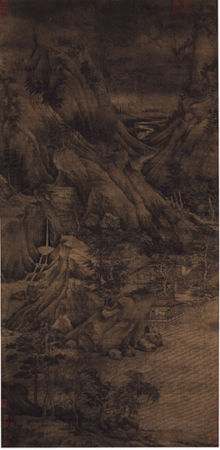James Cahill (art historian)
| James Francis Cahill | |
|---|---|
| Born |
August 13, 1926 Fort Bragg, California |
| Died |
February 14, 2014 (aged 87) Berkeley, California |
| Residence | Berkeley |
| Fields | Art history |
| Institutions |
Freer Gallery of Art University of California, Berkeley |
| Alma mater | |
| Known for | Authority on Chinese art |
| Notable awards | Charles Lang Freer Medal (2010) |
| Children | Sarah, Nicholas, Benedict, Julian |
James Francis Cahill (Chinese: 高居翰; pinyin: Gāo Jūhàn; August 13, 1926 – February 14, 2014) was an art historian, curator, collector, and professor at the University of California, Berkeley. He was considered one of the world's top authorities on Chinese art.[1] [2]
Early life and education
James Cahill was born on August 13, 1926 in Fort Bragg, California. His parents were divorced when he was two, and he lived with a number of relatives and friends. He became interested in literature and music at the Berkeley High School.[3]
In 1943 Cahill entered the University of California, Berkeley, initially to study English, but decided to study Japanese instead because of World War II.[3] He was later drafted into the US Army, and served as a translator in Japan and Korea from 1946 to 1948. In Asia he became interested in collecting paintings.[1][3] In 1948 he returned to UC Berkeley and received a bachelor's degree in Oriental languages in 1950. He then studied art history under Max Loehr at the University of Michigan, earning his master's in 1952 and Ph.D. in 1958.[3] In 1954 and 1955 Cahill studied at Kyoto University in Japan as a Fulbright Scholar.[1]
Career

Cahill worked at the Freer Gallery of Art in Washington, D.C. as curator of Chinese art from 1958 to 1965, when he became a faculty member at UC Berkeley.[3] He taught at Berkeley for 30 years, from 1965 until his retirement in 1995, after which he became professor emeritus.[4] From the late 1950s to the 1970s, when the Western society had far less interest in Chinese art than today, Cahill was among a group of art historians who researched and cataloged Chinese paintings.[1] In 1960 he published Chinese Painting, which became a classic text that was required reading in Chinese art history classes for decades.[3] In 1973, he was one of the first American art historians to visit China after President Richard Nixon's historic meeting with Chairman Mao Zedong the year before.[3]
At a Chinese art symposium in the 1960s, Cahill proposed the theory that notable Ming dynasty Chinese painters were influenced by Western art. His theory was denounced by Chinese academics at the time, but has been widely accepted by experts since then.[3]
In the 1990s, financier Oscar Tang purchased The Riverbank, a famous 10th-century Chinese painting attributed to the Southern Tang dynasty master Dong Yuan, and donated it to the Metropolitan Museum of Art of New York City. In 1999, Cahill set off an explosive debate when he announced that the painting was a fake by the 20th-century master painter and forger Zhang Daqian.[1][3] [5] In addition to his observation's on the painting's style, which he argued could not be that of a Song dynasty painting, he cited the brushwork and seals.[6] The museum insists the painting is authentic, and the work remains on display at the Met. The dispute remains unresolved.[1][3]
James Cahill published hundreds of articles on Chinese and Japanese art, as well as more than a dozen books. [7] He built a significant collection of Chinese and Japanese art, and gave much of it to the Berkeley Art Museum.[4] In 1993 he delivered the Edwin O. Reischauer Lectures at Harvard. In 2010 he was awarded the Charles Lang Freer Medal by the Smithsonian Institution for his lifetime contributions to art history.[8]
Personal life
Cahill was married and divorced twice. He had two children from his first marriage, pianist Sarah Cahill and Nicholas, and two more children from his second marriage, Benedict and Julian. He also had six grandchildren.[3] He died of prostate cancer on February 14, 2014, at the age of 87.[3]
Notes
- 1 2 3 4 5 6 Bowley, Graham (18 February 2014). "James Cahill, Influential Authority on Chinese Art, Dies at 87". New York Times. Retrieved 25 February 2014.
- ↑ About James Cahill
- 1 2 3 4 5 6 7 8 9 10 11 12 Woo, Elaine (21 February 2014). "James Cahill dies at 87; scholar of Chinese art". Los Angeles Times. Retrieved 25 February 2014.
- 1 2 "Professor Emeritus James Cahill, 1926-2014". UC Berkeley. 18 February 2014. Retrieved 25 February 2014.
- ↑ Chang Ta-ch'ien's Forgeries
- ↑ Correspondence With Jerome Silbergeld About Riverbank Revelation
- ↑ James Cahill Bibliography
- ↑ Freer Gallery (2010).
References and further reading
- Freer Gallery (2010), Twelfth Presentation of the Charles Lang Freer Medal November 18, 2010 (PDF), Washington, D.C.: The Smithsonian Institution. Includes biographical remarks on Cahill and a bibliography of his works.
External links
- James Cahill. Website containing Cahill's blog, video lectures, papers, articles, biographical material, and tributes to him.